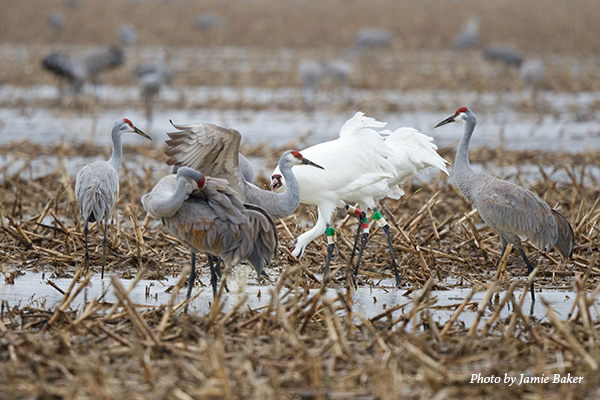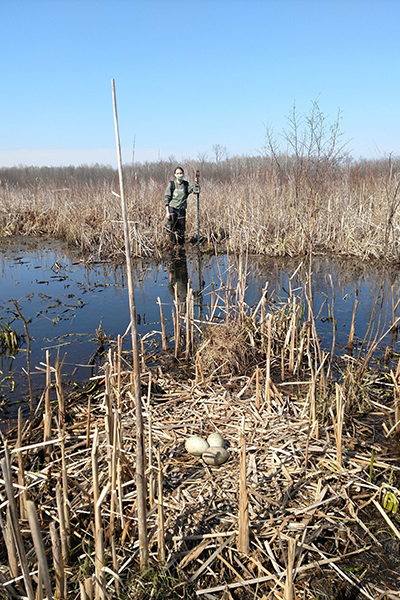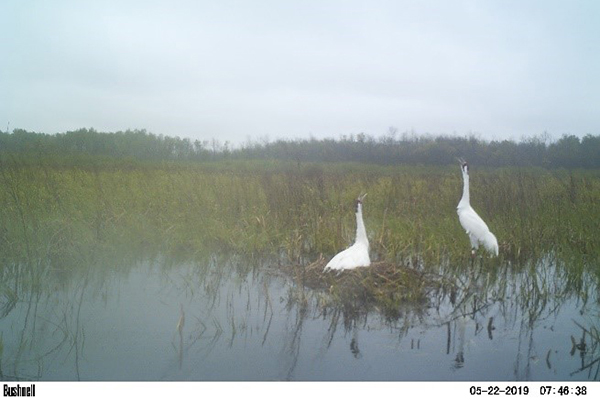
In May 2019, researchers at the International Crane Foundation documented a pair of female Whooping Cranes nesting and incubating eggs at McMillan Marsh Wildlife Area in Marathon County, Wisconsin. This observation, while exciting, was not necessarily unique as many birds, including chinstrap penguins, greater flamingoes, zebra finches, bearded vultures, and even Black-necked Cranes, have been known to exhibit same-sex pairing behaviors. However, a close record of this behavior may help us better understand how Whooping Cranes select their mates and divide incubating duties. In 2019, our team at the International Crane Foundation carefully took record of this pair’s behavior, compared incubating behaviors between male-female pairs, and attempted to understand what is truly driving these same-sex pairings.
Across species exhibiting same-sex pairings, the following hypotheses to explain this behavior have been proposed:
- The birds are breeding in a sex-skewed population where they are in the majority, so finding a mate of the opposite sex is more difficult.
- The birds are breeding in a population where it is very difficult to distinguish a male from a female.
- The birds in same-sex pairings are younger, practicing important breeding, nesting, and incubating behaviors until a mate becomes available.
- The two birds are closely related, and it is in a bird’s best interest to help their relative successfully raise a chick and pass on their genes.
All four of these hypotheses are strong assumptions for why same-sex pairings exist. However, what we observed with the female-female pair at McMillan Marsh Wildlife Area ultimately led us to a different conclusion.
So, let’s take a step back and take a closer look at this female-female pair of Whooping Cranes nesting in Wisconsin. In 2019, our team found 2-15, a four-year-old female Whooping Crane, and 28-05, a 14-year-old female Whooping Crane, sharing a nest with two eggs. Upon this observation, our interest was piqued, and to gather more information about the pair, we set up a nest camera to record their behaviors from May 14 to June 4, when the nest was eventually abandoned.
Ultimately, we found that their behaviors were very similar to a male-female pair. They spent a similar amount of time incubating the eggs on their nest (99.7%), they showed territorial behaviors when we approached the nest, and both females shared incubation duties – changing who is incubating every 3-3.5 hours even in the middle of the night, and they even unison called three times!

These findings were interesting and suggested the female-female pair should be able to hatch a chick if given a fertile egg, which we tried in 2020 when they nested again. As predicted, this pair did hatch a chick. Unfortunately, the chick did not survive long, and 28-05 passed away shortly after. 2-15 then was moved permanently into captivity following a wing injury, ending our work with this pair.
The final question, then, was what caused this unique pairing? As you remember from our hypotheses above, we had four potential drivers to explore.
- The first, being a sex-skewed population, was quickly debunked. The Eastern Migratory Population, which breeds in Wisconsin, has more females than males. Under this assumption, a female-female pair would only exist if there were more males than females.
- Our second assumption was that males and females were difficult to tell apart, which at first glance may appear true. However, because Whooping Crane males and females display very different behaviors that make it easy to identify their sex, we also know this assumption cannot be true.
- Moving to our third assumption, the pair is practicing until they find a mate; we also know this to be untrue. In 2017, a young male Whooping Crane was released near the pair, and the three spent time together on migration while wintering and while back in Wisconsin. The male was even observed near the pair in 2019 when they started nesting, but the pair did not attempt to claim him or any other males as a mate.
- Finally, our fourth assumption was also untrue because the two females are not closely related.

So, what do we think caused this unlikely pairing? Our biologists think this same-sex pair was created because female Whooping Cranes disperse further than males, so they found themselves in a space in Wisconsin with fewer available male Whooping Cranes, and their elevated hormones in the spring encouraged them to breed with one another.
In conclusion, the research our team shared after monitoring this same-sex pair of Whooping Cranes in Wisconsin has helped us to start to understand what drives pair-bonding in Whooping Cranes. Still, future research is needed to truly understand how this behavior will impact the future breeding success of this small, reintroduced population.
We thank Hillary Thompson and Nicole Gordon, the authors of the summarized manuscript “First Description of Nesting Behavior of a Same-Sex Pair of Whooping Cranes (Grus americana) in the Reintroduced Eastern Migratory Population,” for providing us with permission to share their work.
References:
- Thompson, H. T., Gordon, N. M. (2020). First description of nesting behavior of a same-sex pair of Whooping Cranes (Grus americana) in the reintroduced eastern migratory population. Waterbird 43(3-4): 326-332.
Story submitted by Stephanie M. Schmidt, Whooping Crane Outreach Coordinator, and Caitlyn Hughs International Crane Foundation.
